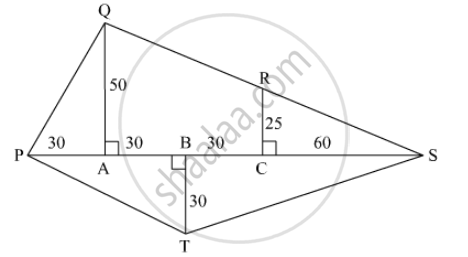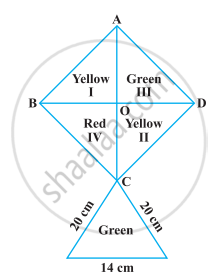Advertisements
Advertisements
प्रश्न
If the side of a rhombus is 10 cm and one diagonal is 16 cm, the area of the rhombus is 96 cm2.
विकल्प
True
False
उत्तर
This statement is True.
Explanation:
To find the area of rhombus, we divide it into two triangles.
As all the sides of a rhombus are equal, we have for a triangle
a = 10, b = 10, c = 16
`s = (a + b + c)/2`
⇒ `s = (10 + 10 + 16)/2 = 36/2 = 18`.
Area (Δ) = `sqrt(s(s - a)(s - b)(s - c))`
⇒ Area (Δ) = `sqrt(18(18 - 10)(18 - 10)(18 - 16))`
⇒ Area (Δ) = `sqrt(18 xx 8 xx 8 xx 2)`
⇒ Area (Δ) = 48 cm2
As the sides of the other triangle are also same, so their areas will also be equal.
Area (Rhombus) = Area (Δ) + Area (Δ)
⇒ Area (Rhombus) = 48 + 48 = 96 cm2
APPEARS IN
संबंधित प्रश्न
Find the area of a triangle whose base and altitude are 5 cm and 4 cm respectively.
Find the area of a triangle whose sides are 3 cm, 4 cm and 5 cm respectively.
Sides of a triangle are cm 45 cm, 39 cm and 42 cm, find its area.
Find the areas of the given plot. (All measures are in metres.)

If the points A(– 3, 9), B(a, b) and C(4, – 5) are collinear and if a + b = 1, then find a and b
The area of triangle formed by the points (− 5, 0), (0, – 5) and (5, 0) is
Using Heron’s formula, find the area of a triangle whose sides are 10 cm, 24 cm, 26 cm
Using Heron’s formula, find the area of a triangle whose sides are 1.8 m, 8 m, 8.2 m
An isosceles right triangle has area 8 cm2. The length of its hypotenuse is ______.
How much paper of each shade is needed to make a kite given in the following figure, in which ABCD is a square with diagonal 44 cm.
